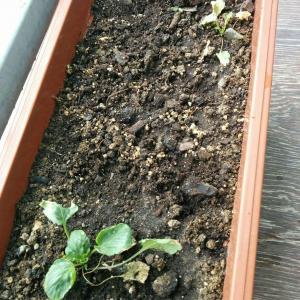文章
Joss
2017年05月22日


Many of us have trouble keeping plants alive in our garden, and have quite the “black thumb”. Either we are too busy to maintain them, or our gardens have issues that make it difficult; hot, dry sites, poor soil or bad weather. Don’t let that stop you from growing flowers! There is hope for even the most murderous of gardeners… you can grow flowers, and you can plant them today and trust they will still be there next year and the year after that. Yes, you still have to make sure they get the occasional drink of water, and make sure you aren’t planting them deep in the barren wasteland of the Arctic…but other than that? Here are TGG’s best picks for easy to grow flowers for any garden. (Oh, and these plants are favs of expert gardeners too!)
Number 5
Thyme (pictured above)
While most of you recognize this as a spice from the kitchen cupboard, there are many very ornamental varieties that can offer texture, color and scent in your garden. Oh, and did I mention they grow like weeds? In a good way, of course. Drought resistant and sun lovers, these plants come in creeping forms to tuck between pavers, and larger varieties that fit right into any garden bed. Flowers are usually white, pink or red, and cover the plants spring through fall. They are fragrant when crushed, make great filler for flower arrangements, and attract butterflies like crazy! These plants come back every year, and yes, you can use them in the kitchen!
Number 4
Cosmos

This flower is an annual, which means it dies after one season, but it reseeds itself so prolifically you would never know it! Each season new seedlings will come up on their own, with no help from you at all. Beautiful daisy like flowers are borne on tall ferny foliage in purples, pinks and whites. All they need is a little water and at least half a day of sun, and they will provide you with armfuls of cut flowers all season long. This is our best budget pick… easily grown from one packet of seeds, and renews itself each year after that with no more seeding needed. Simply rake your spot smooth, sprinkle seeds, lightly cover with dirt and water…That’s it! They will do the rest… This flower is great as filler in a garden bed that has empty spots, or makes a dramatic show as aw hole bed in itself.
Number 3
Mexican Feather Grass
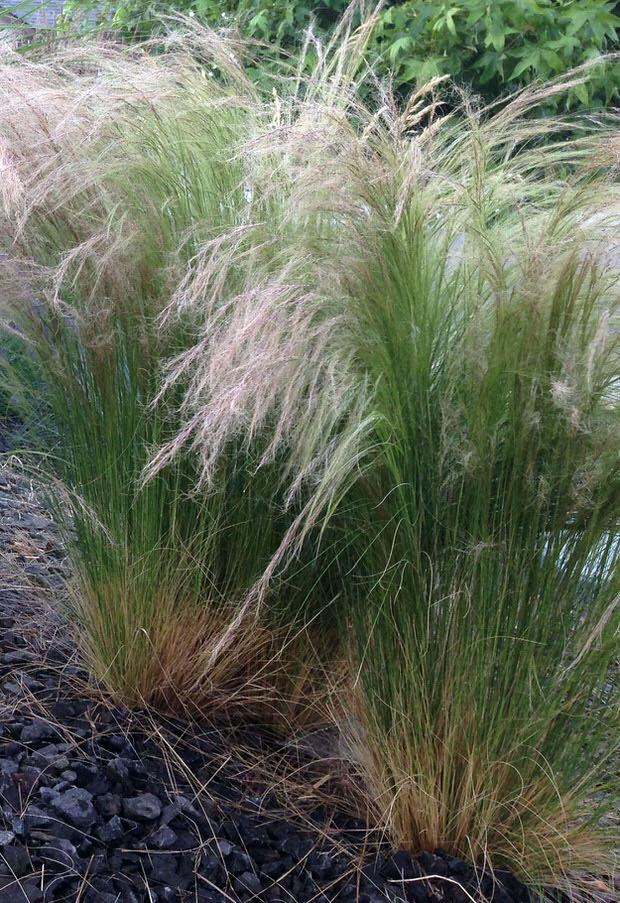
Mexican feather grass is my choice for an unbeatable ornamental grass for my area, but there are similar grasses if you live in a zone colder than 6. This feather grass (Nasella, formerly Stipa) is incredible drought and heat tolerant, self seeds like crazy (may drive you nuts, but eay to pull out if they seed in an unlikely place) and add n updated look to any garden. These little grasses grow to 24 inches and as wide, and are topped with fluffy white “flowers” through the summer. Which, by the way, look fantastic right through the winter after the grass has turned golden brown. You can plant these gems in a modern, more orderly way, or let them create a more natural garden effect. You can pot them into containers, and use them to add texture and movement to a stale garden bed. At TGG we are big fans of all ornamental grasses, but this is one of our go-tos!
Number 2
Coneflowers

The hottest perennial in any nursery right now are coneflowers, and with good reason. Originally purple wildflowers from the prairie states, these new hybrids have been bred to provide incredible color varieties, compact form and still retain the drought and disease resistance of the original plant. We love some of the new tropical colors, like “Flame Thrower” or “Indian Summer”. Also, green and white varieties, and even double flowering forms! Some varieties are great for containers, try Pow Wow Wild Berry, one of our new favs… They require occasional watering, and they bloom better if their spent blooms are removed, although not necessary in may of the newer varieties. Fun fact: The parent plant, Echinacea, is the same herbal supplement many use to ward off colds and fevers!
Our top pick for easiest flower to grow – Number one!
Yarrow

2
2
文章
lenny
2017年05月22日
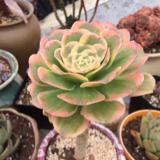

Herb gardens are my favorite type of garden. There is something really satisfying about plants that do it all – they are pretty, fragrant, tasty and even medicinal! They can be grown in a formal style, or rock an old boot! They are practical plants full of nostalgia and charm, and can grace the finest table while tantalizing virtually all the senses. And they have a quality about them they makes you want to bake from scratch, buy organic and pour good wine. But rather than bring you pretty photos of great English herb gardens (ok, there are a few of those here, I confess…) we have some creative outdoor herb gardens and projects to make you an herb convert! Our feature photo above is from ‘Ginger Snap Crafts’. This DIY herb garden project takes a little bit of handy work with tools but we just love it! See how they did it here.
‘Brooklyn Limestone’ created this DIY vertical herb garden, and she shows you how step by step… Perfect if you just want some kitchen herbs right off the back door! I love how she did this, and labeled with a paint pen. But if, and this is a big if, your garden will be under cover, what about using chalkboard paint?


Want a neat herb garden? Plant in pots in the ground, like they did in this garden in France, courtesy of ‘Townmouse‘.

Easy idea for a quick herb garden, that doesn’t lack any charm… from ‘Precious Sister’, this herb wagon garden is just what we all need… seriously, does it get better than this? Also, it is up higher to make sure someone who has knee issues (me) can take care of it. Would this be a great gift for an elderly friend? An herb wagon??? Amazing!

Laura from ‘Finding Home’ is my new hero. This kitchen herb garden is the perfect back porch decor, and yet, it makes sure the parsley is right their when you are cooking Sunday night soup this fall! I love the dishes as accents, and the door? Total charmalicious…

Need a DIY project, and not looking for cute, but just cool? Try this DIY hanging herb garden by ‘Homemade Modern’, made from pine boards, rope and zip ties!

This DIY outdoor living wall was create by ‘Dremel Weekends’ for ‘Curbly’, and this is clearly the way to grow herbs. Plenty of light gets in, easy to water, no weeding, good air circulation… win, win!

Lina at ‘Fancy Frugal Life’ made these DIY stacked herb gardens, complete with chalkboard markers! Great for small gardens that need a space saving solution, or just because you want something with more interest. Cute! Complete tutorial with photos.

This is a really creative idea… DIY herb garden in bottles! 11 Eureka created this from mercury bottles meant to be candleholders… this is far and away a better use for them! I’d love these hung on porches, decks and even in trees!

Ok, now that we have you inspired that you too, can have an herb garden… It’s time to really get inspired!



Last we have the herb garden at Sissinghurst Castle, Just in case you want to dream.

0
0
文章
Abigal
2017年05月22日

Check out these 18 Flowering Ground Cover Plants, you’ll find some best low growing plants on this list, they’re not only easy to grow but looks beautiful too.1. Bigroot Geranium (Geranium macrorrhizum)
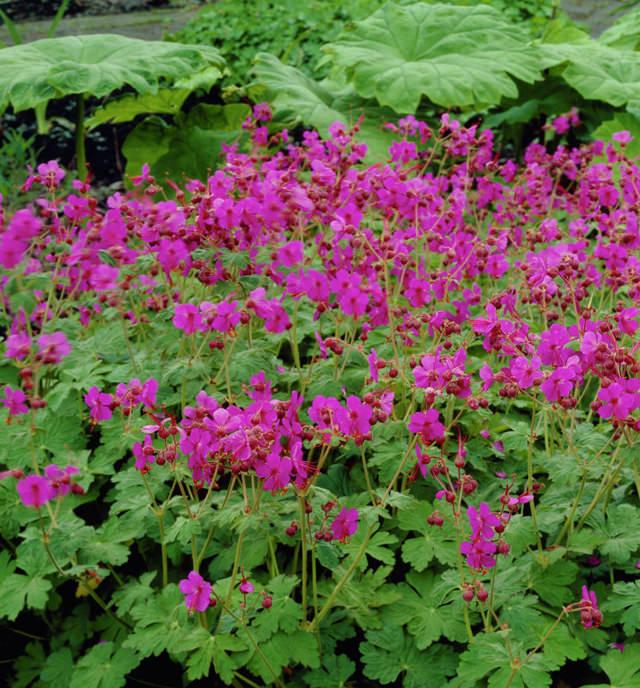
This old fashioned tough and aggressive perennial ground cover is a good choice for gardeners who want to grow low maintenance plants. The plant barely grows up to 1-1.5 feet tall and loves the sun. Blooms appear when the weather warms up in colors like pink, red or pale pink with interesting variegated foliage. You can also plant it in groups under the trees, the bigroot geranium is a drought tolerant plant and best grown in temperates under USDA Zones 4 to 8b.
2. Spotted Dead Nettle
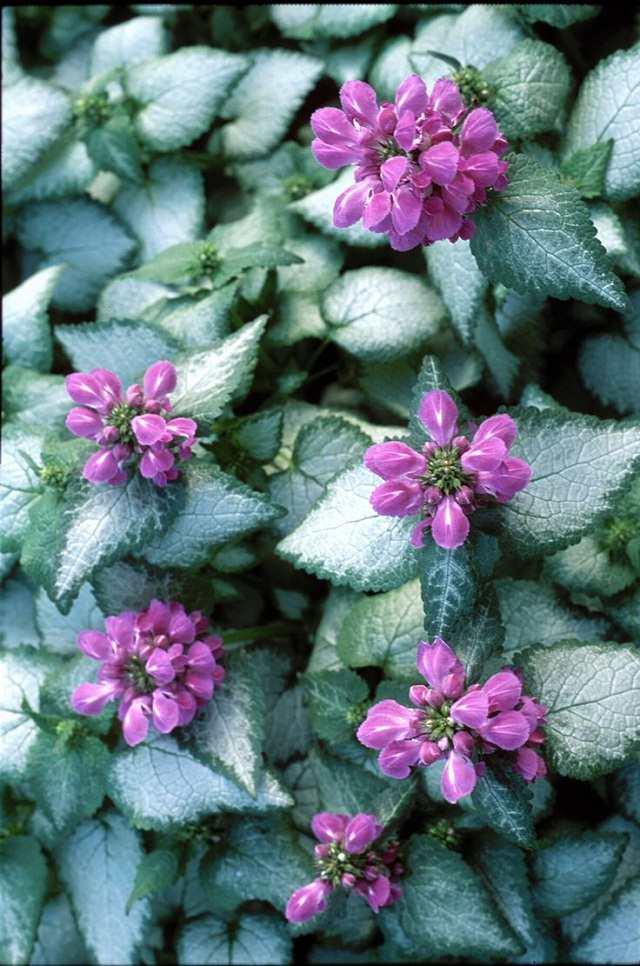
Dead nettle (Lamium maculatum) is notable for both its variegated foliage and its dense clusters of flowers, which appear in a variety of colors, including white, pink and purple (depending on the cultivar). This low growing plant can be grown diversely in different climates (USDA Zones 3-10), providing it cool, moist soil and shade to part shade. However, it must be noted that dead nettle can be invasive and considered as a weed by many gardeners.
3. Moss Rose (Portulaca)

This pretty little plant with needle-like foliage and tiny colorful flowers looks absolutely stunning. It is an annual or perennial (*in warm tropical and subtropical climates) ground cover that spreads densely. The blooms come in yellow, pink, red, white, orange and many more colors. Moss rose is very tolerant of poor conditions and dry soil.
4. Helianthemum

Also called ‘Sun Rose’ or ‘Rock Rose’, this subshrub comes from the family Cistaceae and barely grows up to 1 feet tall. Providing a well-drained soil and full sun (part shade in warmer climates) it blooms happily. The showy flowers of this genus come in shades of orange, pink, yellow, scarlet, and white. There are some varieties available that bloom for a long time from spring to fall (autumn). Grows in USDA Zones 5-9, this plant usually dies back in the colder regions when the winter perks up, whereas in warmer zones it remains evergreen.
5. Lilyturf (Liriope)

Lilyturf is neither a grass nor a lily. This showy and tough groundcover has lush and deep green, grass-like foliage ordered in slightly upright tufts. Spikes of violet or lavender color flowers appear from late summer until the fall.
Lilyturf (USDA Zones 6-10) requires full sun in colder regions but in warm subtropical or tropical climate, you can grow it in dappled shade. It can be grown between tall shrubs and underneath the canopy of trees, also use it for edging walkways or as and a low border accent. Liriope ‘Muscari’ and Liriope ‘Spicata’ are two most popular varieties.
6. Sweet Woodruff
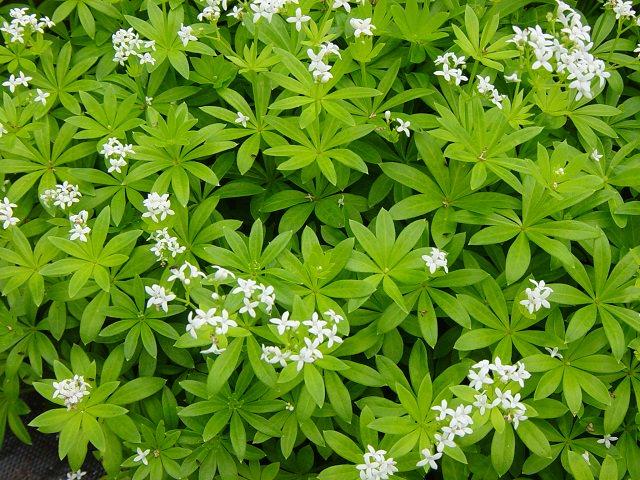
Sweet woodruff is an excellent ground cover if you want to add fragrance to your garden. Grows best in part shade to full shade and on well-drained soil, this plant can grow up to a height of only 8-10 inches (When in bloom). It starts to bloom prolifically from mid-spring, sweet woodruff leaves also release fragrance when crushed.
7. Creeping Thyme

Thymus serpyllum is a low-growing aromatic flowering herb that is perennial and hardy in USDA Zones 4-9. Just like other thyme varieties it is edible too. This tiny plant barely grows up to 3 inches tall. It is deer resistant and an amazing alternative of grasses.
8. Brass Button

If you’re searching for a lawn substitute on which you can set foot without thinking much then consider growing brass button. It also forms yellow-golden flowers that appear from spring to summer. Brass buttons are hardy in USDA Zones 5-10 (but evergreen only in Zone 8-10), growing in temperates to subtropical climates both.
9. Creeping Phlox
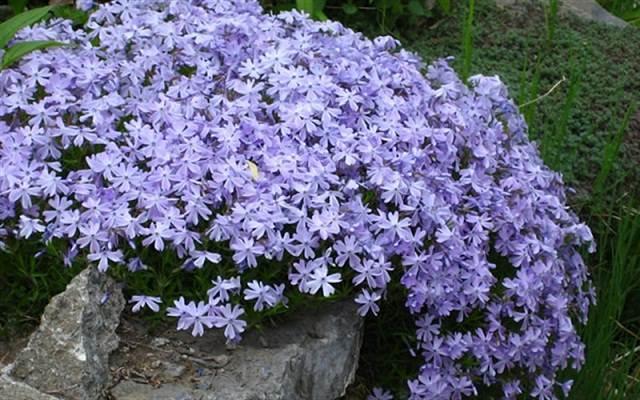
This ground cover has pleasant flowers that appear in pastel hues. Growing this sturdy, low-maintenance plant is possible in USDA Zones 3-8, it is the plant that can be used in landscaping to hide the unsightly slope or other difficult areas as it rambles between rocks or cascades down. It can also be used as a bordering plant around the flowerbeds.
10. Sedum

The genus ‘Sedum’ has a diverse group of ornamental succulent plants, you can grow low growing sedums as a ground cover in full sun and well-drained soil. Yellow flowers appear in summer. The best thing about sedums is there are about 400 species of them around the world that can be grown diversely in every climate.
11. Campanula Portenschlagiana

Campanula portenschlagiana or ‘Dalmatian Bellflower’ is a beautiful annual or perennial plant that forms a mat of small rounded leaves. The flowers are star-shaped, blue-purple in color that blooms from spring through summer. Relatively cold hardy but requires shelter when temperature dips below much. It grows in full sun and in the part shade too, on a fairly loose, well drained and alkaline soil.
12. Lily of the Valley

Lily of the Valley is one of the easiest and best flowering ground covers. Its fragrant little bell-shaped white flowers grow well in shade and have long blooming period. Growing lily of the valley plant is possible in cool temperate zones in USDA Zones 2-9.
13. Vinca minor
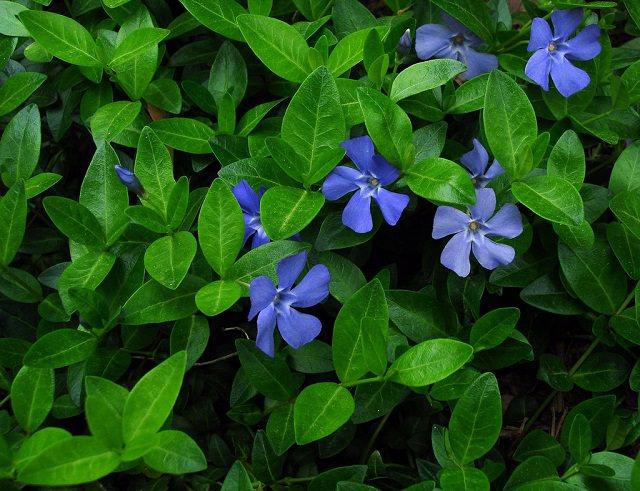
One of the most popular groundcovers, it is a hardy plant in both cold and warm climates under USDA Zones 4-10a that spreads quickly. It blooms prolifically, is easy to grow and tolerates poor soil and drought. Provide it full sun in the cold climate and part shade in warm climates.
14. Veronica ‘Goodness Grows’

This low growing beautiful perennial blooms from summer to fall. Good for country style or cottage style garden and also suitable for containers. With its spiky blue blooms, it looks good with bright green foliage. Veronica ‘Goodness Grows’ requires full sun and regular but moderate watering.
15. Firecracker (Russelia equisetiformis)
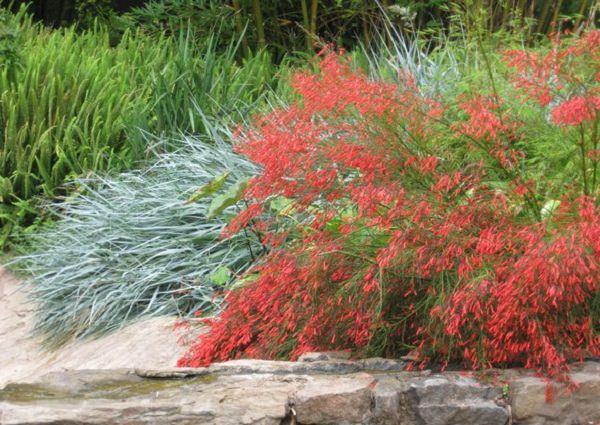
A warm climate plant that grows best in warm temperates, subtropics, and tropics (USDA Zones 8b-11). This drought tolerant plant is loved by nectar-feeding species of birds, and by butterflies. Fluffy, errant and wispy stems and foliage cascade down and camouflages the unsightly areas. It is suitable for slopes, borders, retaining walls and containers too.
16. Lamb’s Ear

One of the best flowering ground cover plants on our list due to its thick attractive silver-grey-green foliage that forms gentle and velvety rosettes, not only the foliage, its purple colored flowers that appear from late spring are appealing too. This excellent edging plant only grows up 12 inches tall in part sun to full sun under USDA Zones 4-9.
17. Society Garlic

Society garlic (Tulbaghia violacea) is also known as ‘Pink agapanthus’. With its edible garlic-flavored purple flowers and clump forming grass like blue-grey foliage, this tough and low maintenance ground cover is a good option for those who live in warmer climates. Suitable for warm temperates, subtropics and tropics under USDA Zones 7-11.
18. Ajuga

Ajuga, which is also called ‘Bugleweed’ is a genus of perennial or annual flowering plants. It becomes an excellent ground cover, sometimes invasive. Many of its species are very popular, especially ‘Ajuga reptans’ that spread through its runners, having attractive foliage that forms a dense carpet-like mat and deep blue flower spikes. It is possible to grow ajuga in both cold and warm climates (USDA Zones, 3-10).

This old fashioned tough and aggressive perennial ground cover is a good choice for gardeners who want to grow low maintenance plants. The plant barely grows up to 1-1.5 feet tall and loves the sun. Blooms appear when the weather warms up in colors like pink, red or pale pink with interesting variegated foliage. You can also plant it in groups under the trees, the bigroot geranium is a drought tolerant plant and best grown in temperates under USDA Zones 4 to 8b.
2. Spotted Dead Nettle

Dead nettle (Lamium maculatum) is notable for both its variegated foliage and its dense clusters of flowers, which appear in a variety of colors, including white, pink and purple (depending on the cultivar). This low growing plant can be grown diversely in different climates (USDA Zones 3-10), providing it cool, moist soil and shade to part shade. However, it must be noted that dead nettle can be invasive and considered as a weed by many gardeners.
3. Moss Rose (Portulaca)

This pretty little plant with needle-like foliage and tiny colorful flowers looks absolutely stunning. It is an annual or perennial (*in warm tropical and subtropical climates) ground cover that spreads densely. The blooms come in yellow, pink, red, white, orange and many more colors. Moss rose is very tolerant of poor conditions and dry soil.
4. Helianthemum

Also called ‘Sun Rose’ or ‘Rock Rose’, this subshrub comes from the family Cistaceae and barely grows up to 1 feet tall. Providing a well-drained soil and full sun (part shade in warmer climates) it blooms happily. The showy flowers of this genus come in shades of orange, pink, yellow, scarlet, and white. There are some varieties available that bloom for a long time from spring to fall (autumn). Grows in USDA Zones 5-9, this plant usually dies back in the colder regions when the winter perks up, whereas in warmer zones it remains evergreen.
5. Lilyturf (Liriope)

Lilyturf is neither a grass nor a lily. This showy and tough groundcover has lush and deep green, grass-like foliage ordered in slightly upright tufts. Spikes of violet or lavender color flowers appear from late summer until the fall.
Lilyturf (USDA Zones 6-10) requires full sun in colder regions but in warm subtropical or tropical climate, you can grow it in dappled shade. It can be grown between tall shrubs and underneath the canopy of trees, also use it for edging walkways or as and a low border accent. Liriope ‘Muscari’ and Liriope ‘Spicata’ are two most popular varieties.
6. Sweet Woodruff

Sweet woodruff is an excellent ground cover if you want to add fragrance to your garden. Grows best in part shade to full shade and on well-drained soil, this plant can grow up to a height of only 8-10 inches (When in bloom). It starts to bloom prolifically from mid-spring, sweet woodruff leaves also release fragrance when crushed.
7. Creeping Thyme

Thymus serpyllum is a low-growing aromatic flowering herb that is perennial and hardy in USDA Zones 4-9. Just like other thyme varieties it is edible too. This tiny plant barely grows up to 3 inches tall. It is deer resistant and an amazing alternative of grasses.
8. Brass Button

If you’re searching for a lawn substitute on which you can set foot without thinking much then consider growing brass button. It also forms yellow-golden flowers that appear from spring to summer. Brass buttons are hardy in USDA Zones 5-10 (but evergreen only in Zone 8-10), growing in temperates to subtropical climates both.
9. Creeping Phlox

This ground cover has pleasant flowers that appear in pastel hues. Growing this sturdy, low-maintenance plant is possible in USDA Zones 3-8, it is the plant that can be used in landscaping to hide the unsightly slope or other difficult areas as it rambles between rocks or cascades down. It can also be used as a bordering plant around the flowerbeds.
10. Sedum

The genus ‘Sedum’ has a diverse group of ornamental succulent plants, you can grow low growing sedums as a ground cover in full sun and well-drained soil. Yellow flowers appear in summer. The best thing about sedums is there are about 400 species of them around the world that can be grown diversely in every climate.
11. Campanula Portenschlagiana

Campanula portenschlagiana or ‘Dalmatian Bellflower’ is a beautiful annual or perennial plant that forms a mat of small rounded leaves. The flowers are star-shaped, blue-purple in color that blooms from spring through summer. Relatively cold hardy but requires shelter when temperature dips below much. It grows in full sun and in the part shade too, on a fairly loose, well drained and alkaline soil.
12. Lily of the Valley

Lily of the Valley is one of the easiest and best flowering ground covers. Its fragrant little bell-shaped white flowers grow well in shade and have long blooming period. Growing lily of the valley plant is possible in cool temperate zones in USDA Zones 2-9.
13. Vinca minor

One of the most popular groundcovers, it is a hardy plant in both cold and warm climates under USDA Zones 4-10a that spreads quickly. It blooms prolifically, is easy to grow and tolerates poor soil and drought. Provide it full sun in the cold climate and part shade in warm climates.
14. Veronica ‘Goodness Grows’

This low growing beautiful perennial blooms from summer to fall. Good for country style or cottage style garden and also suitable for containers. With its spiky blue blooms, it looks good with bright green foliage. Veronica ‘Goodness Grows’ requires full sun and regular but moderate watering.
15. Firecracker (Russelia equisetiformis)

A warm climate plant that grows best in warm temperates, subtropics, and tropics (USDA Zones 8b-11). This drought tolerant plant is loved by nectar-feeding species of birds, and by butterflies. Fluffy, errant and wispy stems and foliage cascade down and camouflages the unsightly areas. It is suitable for slopes, borders, retaining walls and containers too.
16. Lamb’s Ear

One of the best flowering ground cover plants on our list due to its thick attractive silver-grey-green foliage that forms gentle and velvety rosettes, not only the foliage, its purple colored flowers that appear from late spring are appealing too. This excellent edging plant only grows up 12 inches tall in part sun to full sun under USDA Zones 4-9.
17. Society Garlic

Society garlic (Tulbaghia violacea) is also known as ‘Pink agapanthus’. With its edible garlic-flavored purple flowers and clump forming grass like blue-grey foliage, this tough and low maintenance ground cover is a good option for those who live in warmer climates. Suitable for warm temperates, subtropics and tropics under USDA Zones 7-11.
18. Ajuga

Ajuga, which is also called ‘Bugleweed’ is a genus of perennial or annual flowering plants. It becomes an excellent ground cover, sometimes invasive. Many of its species are very popular, especially ‘Ajuga reptans’ that spread through its runners, having attractive foliage that forms a dense carpet-like mat and deep blue flower spikes. It is possible to grow ajuga in both cold and warm climates (USDA Zones, 3-10).
1
0
文章
Abigal
2017年05月22日

Add a vertical touch in your container garden by growing climbing plants for containers. Must see these 24 best vines for pots.
The climbing plants in pots can bring a real touch of nature to any place, and they are a good way to add some privacy, too. These plants will create a nest of greenery where you can relax and rejuvenate and harbor in the mild soothing fragrance and lively colors.
1. Ivy

Ivy is one of the best climbers for containers. Its ability to adapt to all types of position makes it an excellent choice for beginners. It can grow up to 80 feet high, and its evergreen foliage remains green even in winters. Plant it in a container that is wide and shallow rather than narrow and deep.
2. Morning Glory

Morning glories are a good option and one of the best creepers or vines for containers. This old-fashioned plant is easy to grow.
3. Clematis

Clematis is the perfect plant to add vertical height and interest to any container garden. Plant clematis in a large container. Fertilize this plant regularly and make sure to always water it thoroughly and deeply.
4. Virginia Creeper

Virginia Creeper’s foliage turn into a beautiful red in the autumn. You can also grow it in a pot, even on a balcony. It improves privacy! To grow this, find a really big container and provide sturdy support of a trellis.
5. Climbing Hydrangea
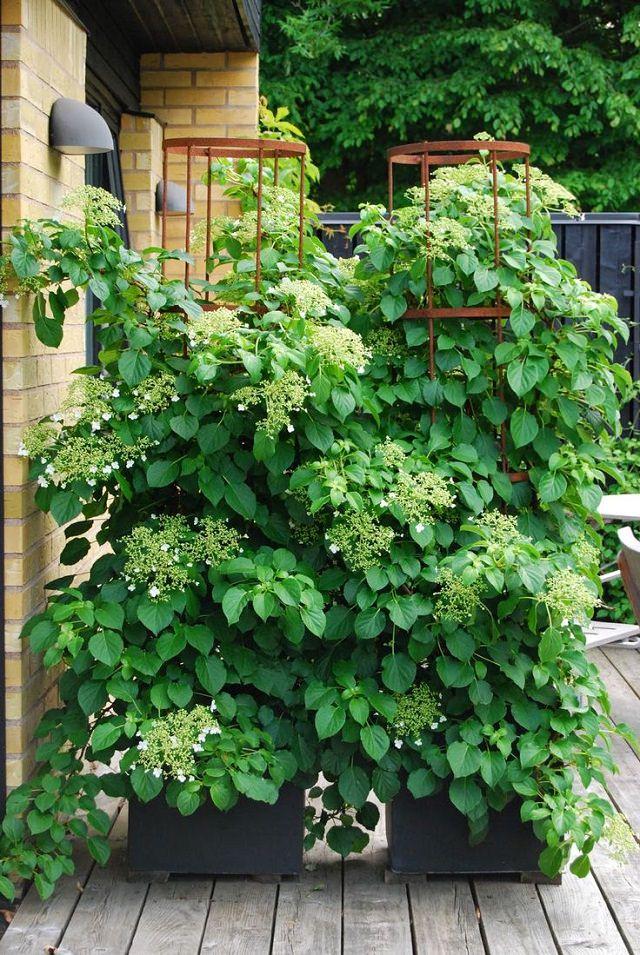
Climbing hydrangea is a great option, if you live under the USDA Zones 5-8 and have a lot of room as this vine can grow up to 70 feet long. It is shade tolerant and thrives best in semi-shaded positions. This plant needs a large pot of about of the size of the half of a whiskey barrel.
6. Trumpet vine

This big (up to 40 ft.) and a fast growing vine is considered as a weed in some parts due to its invasiveness. Despite the fact, this plant is famous for its trumpet-shaped flowers that come in shades of yellow to red and attract hummingbirds. Trumpet vine is more suitable for warm temperates, still it can acclimatize and grow in cooler regions if the protection from cold is provided in winter.
7. Bougainvillea

The bougainvillea is not a vine but a climbing shrub, it is easy to grow, colorful and controllable. You can grow it to give a tropical touch to your container garden. As bougainvillea is a tropical plant, the protection in winter is required in temperate zones.
8. Honeysuckle

There are about 180 different varieties of honeysuckle available as vines and creepers and can be grown diversely in a variety of climates (USDA Zones 3-11). Most of the honeysuckle varieties are evergreen in warmer climates. When growing honeysuckle, place the plant in full sun and do a regular watering. Occasional feeding with balanced fertilizer is enough.
9. Wisteria

Wisteria is one the most popular vines and it grows best in moderately cool climate. It can become huge, however, by providing solid support to the wisteria vine and some space you can grow it in a container, too. Also, it is required that you transplant this plant time to time into one size bigger pot. You can learn how to grow wisteria in a pot here.
10. Common Jasmine

Truly the most fragrant flower. Even its heady fragrance is sometimes too much for some people. The Jasminum Officinalis is easy to grow in containers and requires well-draining soil and warmth (hardy in USDA Zones 8-11) to thrive. The plant usually blooms in summer but in tropics, jasmines are evergreen and in flower most of the year.
11. Confederate Jasmine

Confederate jasmine is a robust plant. It has moderate watering needs and doesn’t mind the hot and humid weather. Similar to other jasmines, it also likes warm climate and exposure to the sun. The beautiful star-shaped flowers appear in clusters. This vine is suitable for containers as it only grows up to 20 ft. long.
12. Climbing Rose
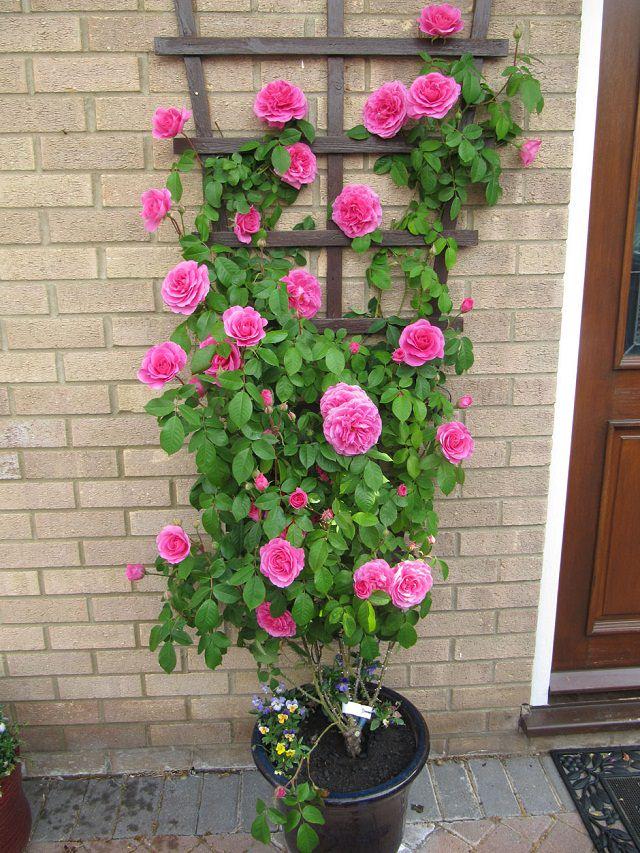
Climbing roses bloom prolifically, many varieties have a pleasant rosy scent. Consider the overall mature size of the variety that you are going to grow and the time you can devote to it, as roses require care and maintenance. Prune the plant on time and regularly remove the faded flowers to keep it in an attractive appearance.
Also Read: How to Make a Container Rose Garden
13. Mandevilla

Mandevilla is an eye catcher. With proper care and an optimal location to enjoy the graceful, funnel-shaped flowers of this plant appear all summer. However, Mandevilla requires warm climate to thrive but you can still grow it as an annual in cooler zones.
14. Cup and Saucer Vine

Cup and saucer vine is a fast growing abundant flowering plant that is native to Mexico. It blooms prolifically but to do this the plant needs an optimal bright location. In temperates, you can grow it either as an annual or protect the plant from winter by keeping it indoors.
15. Passion Flower

One of the most beautiful privacy protection plant for a container garden. If you prefer an exotic flair and extraordinary flowers, the passion flower is a right choice for you. It is important that you provide it sufficient sun. The passion flower is slightly frost resistant, but it should spend its time in a favorable spot in the winters.
16. Black-eyed Susan

Black-eyed Susan is a perennial vine that requires a sunny place and a trellis to climb on. This period flowering climbing plant can reach a height of over two meters with good care! Thus, the Black-eyed Susan is ideal if you want color and privacy in your container garden.
17. Dutchman’s Pipe
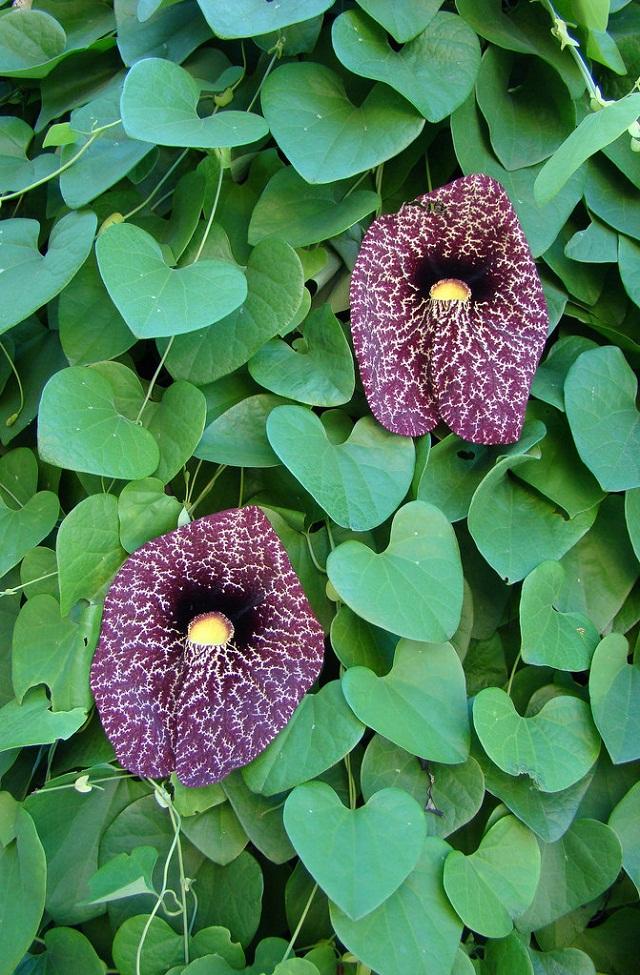
If you are looking for an unusual plant for your container garden, plant the dutchman’s pipe. The lush, large and heart-shaped foliage also provide interest apart from flowers that have a mildly unpleasant odor. Growing this unique plant as a perennial is only possible in warm subtropical or tropical climates. Everywhere else (as the plant is not frost tolerant) it must be grown in a greenhouse or indoors.
18. Butterfly Pea

Butterfly pea is a tropical vine and grows best in USDA Zones 10 and 11. In a cold temperate zone, grow this perennial as an annual. Plant it in a medium to a large sized container with a trellis to climb on from the initial stage.
19. Moonflower

Moonflower is a fantastic night blooming plant with large trumpet-shaped fragrant flowers. Place the pot near your patio or bedroom window to enjoy its fragrance in the night but make sure the place receives morning sun and light afternoon shade. Deadhead or remove the spent blooms to encourage more flowers.
20. Asarina Scandens
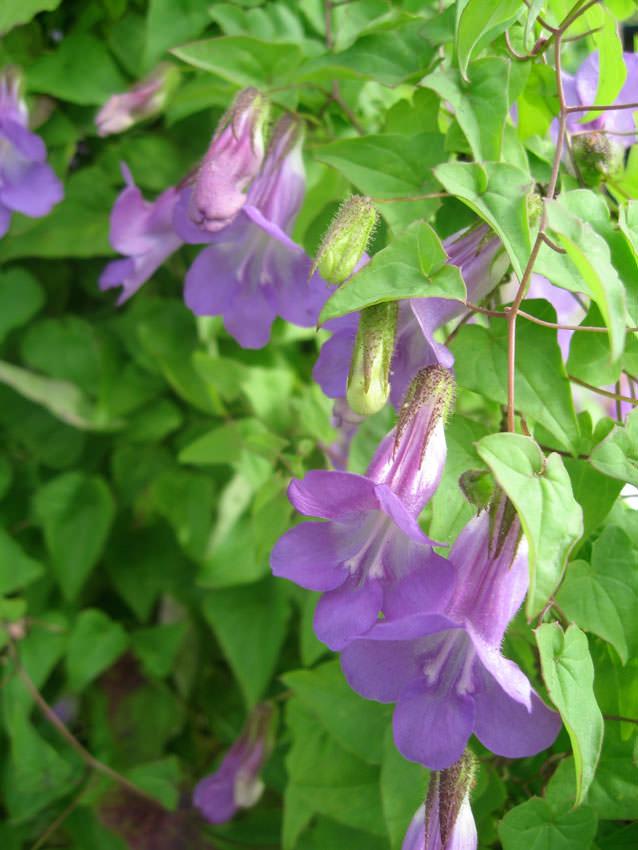
Asarina, which is also known as climbing snapdragon is perfect for growing in containers as it seldom exceeds the height of 8-10 feet. Many hybrid cultivars are available in the shade of different colors. You can also use this vine in hanging baskets or as a groundcover. Asarina is more a warm climate plant and often grown as an annual in temperates.
21. Canary Creeper
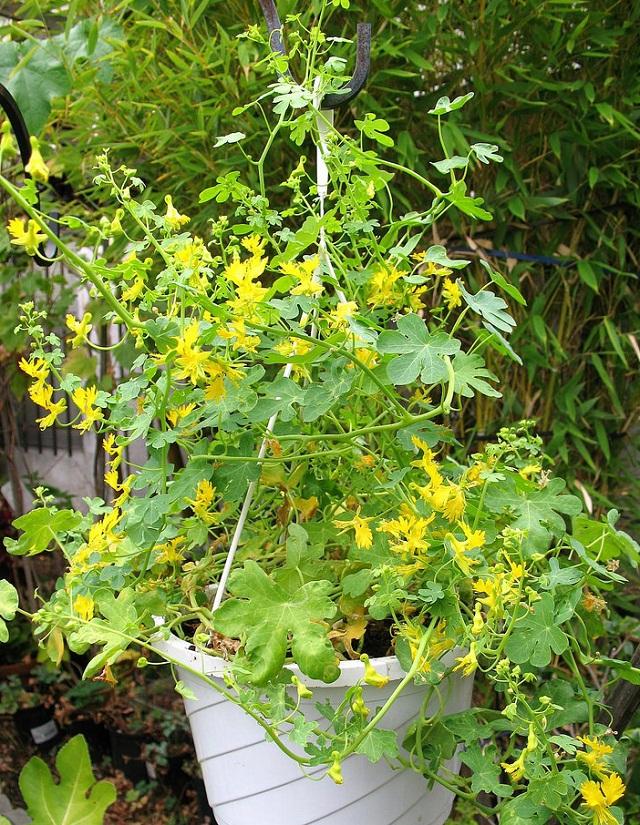
Let this annual vine ramble up on a trellis, and it will award you with its showy yellow flowers that look unmatchable. The canary creeper has long blooming period from summer to fall and even more in warm subtropical regions where it is perennial (USDA Zone 9 and higher).
22. Sweet Pea
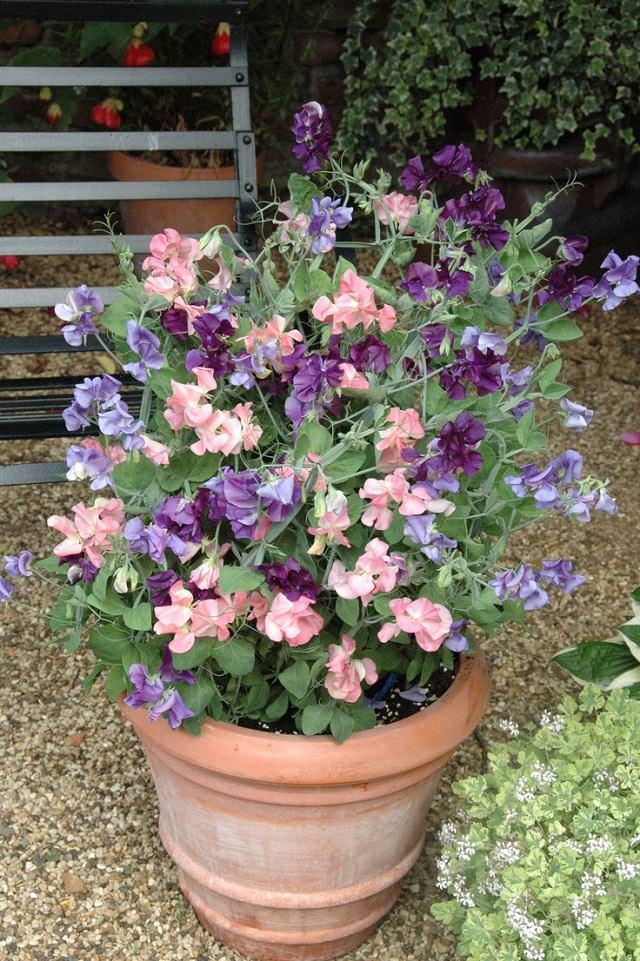
Grow sweet peas in warm zones in fall and winter. In temperates, plant this fragrant vine in spring or summer. When growing in containers choose bush type varieties.
23. Sweet Autumn Clematis

Sweet autumn clematis vine forms masses of amazingly fragrant flowers from late summer to fall (autumn). You can grow this vine diversely in both the cold and warm climates (USDA Zones 4-9). Also, in subtropical and tropical climates if shade from afternoon sun is provided.
24. Snail Vine

This beautiful tropical vine has rare snail-like fragrant flowers that are white in the beginning and later unfurl to lavender pink. However, it’s easy to grow snail vine in non-tropical zones, but the plant dies in winter and returns again in the spring.
The climbing plants in pots can bring a real touch of nature to any place, and they are a good way to add some privacy, too. These plants will create a nest of greenery where you can relax and rejuvenate and harbor in the mild soothing fragrance and lively colors.
1. Ivy

Ivy is one of the best climbers for containers. Its ability to adapt to all types of position makes it an excellent choice for beginners. It can grow up to 80 feet high, and its evergreen foliage remains green even in winters. Plant it in a container that is wide and shallow rather than narrow and deep.
2. Morning Glory

Morning glories are a good option and one of the best creepers or vines for containers. This old-fashioned plant is easy to grow.
3. Clematis

Clematis is the perfect plant to add vertical height and interest to any container garden. Plant clematis in a large container. Fertilize this plant regularly and make sure to always water it thoroughly and deeply.
4. Virginia Creeper

Virginia Creeper’s foliage turn into a beautiful red in the autumn. You can also grow it in a pot, even on a balcony. It improves privacy! To grow this, find a really big container and provide sturdy support of a trellis.
5. Climbing Hydrangea

Climbing hydrangea is a great option, if you live under the USDA Zones 5-8 and have a lot of room as this vine can grow up to 70 feet long. It is shade tolerant and thrives best in semi-shaded positions. This plant needs a large pot of about of the size of the half of a whiskey barrel.
6. Trumpet vine

This big (up to 40 ft.) and a fast growing vine is considered as a weed in some parts due to its invasiveness. Despite the fact, this plant is famous for its trumpet-shaped flowers that come in shades of yellow to red and attract hummingbirds. Trumpet vine is more suitable for warm temperates, still it can acclimatize and grow in cooler regions if the protection from cold is provided in winter.
7. Bougainvillea

The bougainvillea is not a vine but a climbing shrub, it is easy to grow, colorful and controllable. You can grow it to give a tropical touch to your container garden. As bougainvillea is a tropical plant, the protection in winter is required in temperate zones.
8. Honeysuckle

There are about 180 different varieties of honeysuckle available as vines and creepers and can be grown diversely in a variety of climates (USDA Zones 3-11). Most of the honeysuckle varieties are evergreen in warmer climates. When growing honeysuckle, place the plant in full sun and do a regular watering. Occasional feeding with balanced fertilizer is enough.
9. Wisteria

Wisteria is one the most popular vines and it grows best in moderately cool climate. It can become huge, however, by providing solid support to the wisteria vine and some space you can grow it in a container, too. Also, it is required that you transplant this plant time to time into one size bigger pot. You can learn how to grow wisteria in a pot here.
10. Common Jasmine

Truly the most fragrant flower. Even its heady fragrance is sometimes too much for some people. The Jasminum Officinalis is easy to grow in containers and requires well-draining soil and warmth (hardy in USDA Zones 8-11) to thrive. The plant usually blooms in summer but in tropics, jasmines are evergreen and in flower most of the year.
11. Confederate Jasmine

Confederate jasmine is a robust plant. It has moderate watering needs and doesn’t mind the hot and humid weather. Similar to other jasmines, it also likes warm climate and exposure to the sun. The beautiful star-shaped flowers appear in clusters. This vine is suitable for containers as it only grows up to 20 ft. long.
12. Climbing Rose

Climbing roses bloom prolifically, many varieties have a pleasant rosy scent. Consider the overall mature size of the variety that you are going to grow and the time you can devote to it, as roses require care and maintenance. Prune the plant on time and regularly remove the faded flowers to keep it in an attractive appearance.
Also Read: How to Make a Container Rose Garden
13. Mandevilla

Mandevilla is an eye catcher. With proper care and an optimal location to enjoy the graceful, funnel-shaped flowers of this plant appear all summer. However, Mandevilla requires warm climate to thrive but you can still grow it as an annual in cooler zones.
14. Cup and Saucer Vine

Cup and saucer vine is a fast growing abundant flowering plant that is native to Mexico. It blooms prolifically but to do this the plant needs an optimal bright location. In temperates, you can grow it either as an annual or protect the plant from winter by keeping it indoors.
15. Passion Flower

One of the most beautiful privacy protection plant for a container garden. If you prefer an exotic flair and extraordinary flowers, the passion flower is a right choice for you. It is important that you provide it sufficient sun. The passion flower is slightly frost resistant, but it should spend its time in a favorable spot in the winters.
16. Black-eyed Susan

Black-eyed Susan is a perennial vine that requires a sunny place and a trellis to climb on. This period flowering climbing plant can reach a height of over two meters with good care! Thus, the Black-eyed Susan is ideal if you want color and privacy in your container garden.
17. Dutchman’s Pipe

If you are looking for an unusual plant for your container garden, plant the dutchman’s pipe. The lush, large and heart-shaped foliage also provide interest apart from flowers that have a mildly unpleasant odor. Growing this unique plant as a perennial is only possible in warm subtropical or tropical climates. Everywhere else (as the plant is not frost tolerant) it must be grown in a greenhouse or indoors.
18. Butterfly Pea

Butterfly pea is a tropical vine and grows best in USDA Zones 10 and 11. In a cold temperate zone, grow this perennial as an annual. Plant it in a medium to a large sized container with a trellis to climb on from the initial stage.
19. Moonflower

Moonflower is a fantastic night blooming plant with large trumpet-shaped fragrant flowers. Place the pot near your patio or bedroom window to enjoy its fragrance in the night but make sure the place receives morning sun and light afternoon shade. Deadhead or remove the spent blooms to encourage more flowers.
20. Asarina Scandens

Asarina, which is also known as climbing snapdragon is perfect for growing in containers as it seldom exceeds the height of 8-10 feet. Many hybrid cultivars are available in the shade of different colors. You can also use this vine in hanging baskets or as a groundcover. Asarina is more a warm climate plant and often grown as an annual in temperates.
21. Canary Creeper

Let this annual vine ramble up on a trellis, and it will award you with its showy yellow flowers that look unmatchable. The canary creeper has long blooming period from summer to fall and even more in warm subtropical regions where it is perennial (USDA Zone 9 and higher).
22. Sweet Pea

Grow sweet peas in warm zones in fall and winter. In temperates, plant this fragrant vine in spring or summer. When growing in containers choose bush type varieties.
23. Sweet Autumn Clematis

Sweet autumn clematis vine forms masses of amazingly fragrant flowers from late summer to fall (autumn). You can grow this vine diversely in both the cold and warm climates (USDA Zones 4-9). Also, in subtropical and tropical climates if shade from afternoon sun is provided.
24. Snail Vine

This beautiful tropical vine has rare snail-like fragrant flowers that are white in the beginning and later unfurl to lavender pink. However, it’s easy to grow snail vine in non-tropical zones, but the plant dies in winter and returns again in the spring.
1
0
文章
Abigal
2017年05月22日

Check out 44 Best Shrubs for Containers. You might know some plants and some may surprise you but one thing is sure– You’ll like to have some of these shrubs right away in your container garden.
Whether you have a small patio garden, a roof top garden, a balcony garden or a big backyard garden this list of best shrubs for containers will provide you so many options to choose from.
Best Shrubs for Containers1. Abutilon (Flowering Maple)

USDA Zones— 8 – 11
Climate— A subtropical shrub that can also be grown in cold climates, keep it indoors in winter.
It is also called “Indian Mallow” or “Flowering Maple”. Abutilon is a beautiful shrub that grows around 1 m tall when grown in containers and have beautiful hibiscus and hollyhock-like flowers.
2. Andromeda

USDA Zones— 5 to 9
Climate— It grows in temperate to subtropical climates. Growing requirements are similar to Azalea, which means it requires acidic soil in order to grow.
“Pieris Japonica” or “Lily of the valley shrub” is a great bush for container gardens. With some attention and care, it can grow up to 2 m tall.
3. Anisodontea

USDA Zones— 9 – 11
Climate— Beautiful shrub, suitable for both warm tropical climate and temperates. In colder regions you can grow it from summer to fall (autumn).
This charming South African shrub grows in full sun and requires dry soil to thrive. A balcony, terrace (roof) or patio facing south or West is perfect for this shrub. It pleases the eyes with its almost continuous flowering.
4. Aster

USDA Zones— 3 – 8
Climate— Suitable for cool temperate zones with mild summers but can be grown in tropics in winter
Aster comes in a variety of colors and blooms prolifically. It is an easy to grow plant that blooms in summer and fall. Both annual and perennial varieties are available.
5. Aucuba Japonica

USDA Zones— 7 – 10
Climate— Subtropical and mildly temperate. In colder zones, grow it indoors.
Also called “Gold Dust” due to its speckled foliage. It is one of the best shrubs for containers. You can grow it for its beautiful foliage as its flowers are not as aesthetic. It is a low maintenance perennial plant that can grow up to 2 m (8-10 f) tall.
6. Azalea

USDA Zones— 4 – 9
Climate— Climate with adequate rainfall and moist summer.
Azalea is definitely one of the most profusely blooming flowering plants. It requires moist soil, partial sun and acidic soil in order to thrive.
7. Bougainvillea

USDA Zones— 9 – 12
Climate— Tropics, subtropics, grow it as a houseplant in colder regions.
This beautiful ever blooming perennial shrub is so vibrant and colorful and almost require no care in tropical and subtropical areas. It requires full sun and dry soil to thrive and it is not susceptible to many pests and diseases.
8. Brugmansia

USDA Zones— 9 – 11
Climate— Brugmansia is a tropical evergreen shrub but it is also easy to grow in cold climates. To overwinter it, keep it indoors when the temperature starts to dip down below 50 F (10 C).
Brugmansia flowers smell well in the night and attracts pollinators. Growing Brugmansia in a pot is easy. It is also called “Angel’s Trumpet”, and it is often confused with datura.
9. Buddleia (Butterfly Bush)

USDA Zones— 5 – 11
Climate— Butterfly bush can be grown in both temperate and tropical zones, wooly butterfly bush grows well in tropics.
More commonly known as the “Butterfly Bush”, buddleia offers abundant flowering panicles with white to red through pink to purple or blue colors. Grow a dwarf variety in a large and deep pot. Remember that due to its rapid growth, it requires regular pruning and fertilization.
10. Boxwood

USDA Zones— 5 – 11
Climate— Boxwood is the most versatile shrub, it grows almost everywhere in all the continents.
The most adaptable and easy to grow shrub, boxwood is landscapers’ favorite and without a doubt one of the best shrubs for the containers.
11. Calamansi

USDA Zones— 9 – 11
Climate— Like all citruses, calamansi is a tropical fruit tree. You can also grow it in cooler zones in containers and keep it indoors in winters.
It has rather a bushy growth and doesn’t not exceed a height of 2 m. Thus, a suitable shrub for container gardening.
Also Read: How to Grow Calamansi
12. Callistemon (Bottlebrush)

USDA Zones— 8 – 11
Climate— Bottlebrush grows in climates with mild winters, easily in tropics. You can grow bottle brush in cooler zones in the pot but it requires care in winter.
A Beautiful shrub that attracts pollinators and looks exquisite in its bright red blooms, it also comes in other colors like purplish pink, lemon yellow or white.
13. Camellia

USDA Zones— 6 – 10a
Climate— Camellia grows best in the climates with mild summer. In temperates to subtropics.
It is a beautiful flowering shrub but when grown in pots, it becomes demanding. Camellia requires humus rich acidic soil and regular maintenance. You can read a helpful article on growing camellias in pots here.
Whether you have a small patio garden, a roof top garden, a balcony garden or a big backyard garden this list of best shrubs for containers will provide you so many options to choose from.
Best Shrubs for Containers1. Abutilon (Flowering Maple)

USDA Zones— 8 – 11
Climate— A subtropical shrub that can also be grown in cold climates, keep it indoors in winter.
It is also called “Indian Mallow” or “Flowering Maple”. Abutilon is a beautiful shrub that grows around 1 m tall when grown in containers and have beautiful hibiscus and hollyhock-like flowers.
2. Andromeda

USDA Zones— 5 to 9
Climate— It grows in temperate to subtropical climates. Growing requirements are similar to Azalea, which means it requires acidic soil in order to grow.
“Pieris Japonica” or “Lily of the valley shrub” is a great bush for container gardens. With some attention and care, it can grow up to 2 m tall.
3. Anisodontea

USDA Zones— 9 – 11
Climate— Beautiful shrub, suitable for both warm tropical climate and temperates. In colder regions you can grow it from summer to fall (autumn).
This charming South African shrub grows in full sun and requires dry soil to thrive. A balcony, terrace (roof) or patio facing south or West is perfect for this shrub. It pleases the eyes with its almost continuous flowering.
4. Aster

USDA Zones— 3 – 8
Climate— Suitable for cool temperate zones with mild summers but can be grown in tropics in winter
Aster comes in a variety of colors and blooms prolifically. It is an easy to grow plant that blooms in summer and fall. Both annual and perennial varieties are available.
5. Aucuba Japonica

USDA Zones— 7 – 10
Climate— Subtropical and mildly temperate. In colder zones, grow it indoors.
Also called “Gold Dust” due to its speckled foliage. It is one of the best shrubs for containers. You can grow it for its beautiful foliage as its flowers are not as aesthetic. It is a low maintenance perennial plant that can grow up to 2 m (8-10 f) tall.
6. Azalea

USDA Zones— 4 – 9
Climate— Climate with adequate rainfall and moist summer.
Azalea is definitely one of the most profusely blooming flowering plants. It requires moist soil, partial sun and acidic soil in order to thrive.
7. Bougainvillea

USDA Zones— 9 – 12
Climate— Tropics, subtropics, grow it as a houseplant in colder regions.
This beautiful ever blooming perennial shrub is so vibrant and colorful and almost require no care in tropical and subtropical areas. It requires full sun and dry soil to thrive and it is not susceptible to many pests and diseases.
8. Brugmansia

USDA Zones— 9 – 11
Climate— Brugmansia is a tropical evergreen shrub but it is also easy to grow in cold climates. To overwinter it, keep it indoors when the temperature starts to dip down below 50 F (10 C).
Brugmansia flowers smell well in the night and attracts pollinators. Growing Brugmansia in a pot is easy. It is also called “Angel’s Trumpet”, and it is often confused with datura.
9. Buddleia (Butterfly Bush)

USDA Zones— 5 – 11
Climate— Butterfly bush can be grown in both temperate and tropical zones, wooly butterfly bush grows well in tropics.
More commonly known as the “Butterfly Bush”, buddleia offers abundant flowering panicles with white to red through pink to purple or blue colors. Grow a dwarf variety in a large and deep pot. Remember that due to its rapid growth, it requires regular pruning and fertilization.
10. Boxwood

USDA Zones— 5 – 11
Climate— Boxwood is the most versatile shrub, it grows almost everywhere in all the continents.
The most adaptable and easy to grow shrub, boxwood is landscapers’ favorite and without a doubt one of the best shrubs for the containers.
11. Calamansi

USDA Zones— 9 – 11
Climate— Like all citruses, calamansi is a tropical fruit tree. You can also grow it in cooler zones in containers and keep it indoors in winters.
It has rather a bushy growth and doesn’t not exceed a height of 2 m. Thus, a suitable shrub for container gardening.
Also Read: How to Grow Calamansi
12. Callistemon (Bottlebrush)

USDA Zones— 8 – 11
Climate— Bottlebrush grows in climates with mild winters, easily in tropics. You can grow bottle brush in cooler zones in the pot but it requires care in winter.
A Beautiful shrub that attracts pollinators and looks exquisite in its bright red blooms, it also comes in other colors like purplish pink, lemon yellow or white.
13. Camellia

USDA Zones— 6 – 10a
Climate— Camellia grows best in the climates with mild summer. In temperates to subtropics.
It is a beautiful flowering shrub but when grown in pots, it becomes demanding. Camellia requires humus rich acidic soil and regular maintenance. You can read a helpful article on growing camellias in pots here.
0
0
文章
Abigal
2017年05月22日

Want more flowers in your garden? Here’re 7 tips you should know to keep your plants blooming.1. Use rich soil

Soil that is light and rich in compost or manure provides plenty of nutrients constantly to the plants. A soil that is rich in organic matter also encourages bacterial activity that promotes soil fertility. Add some compost or manure to the soil when planting your plants and go adding them time to time.
2. Deadhead often

Most plants grow better and have more flowers if their wilted and faded blooms are plucked often. When you see the wilted flowers, remove them, so the plant can direct its energy on other flowers and they will be receiving more nutrients. Wilted flowers waste energy and sap. They also attract insect and pests. Also, by cutting off the spent flowers you prevent plants from seeding.
3. Fertilize the plants
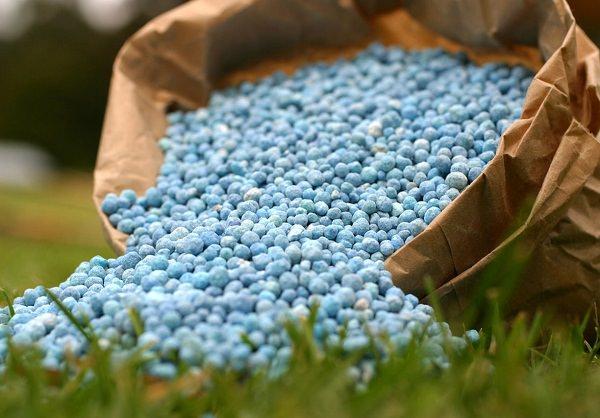
To have more flowers, feed the plants regularly during the growing season with half strength liquid fertilizer, a flowering fertilizer should be used that has more phosphorus than nitrogen, as phosphorus is the element that promotes more flower buds. Also, you can mix time-based fertilizer in the soil at the beginning of the growing season.
4. Provide more sun

Light is essential for the plant’s growth, direct sunlight for several hours a day can be a prerequisite for many plants that come to flower, however, shade loving plants tend to reduce the number of flowers when exposed to more sun.
5. Nurse the roots
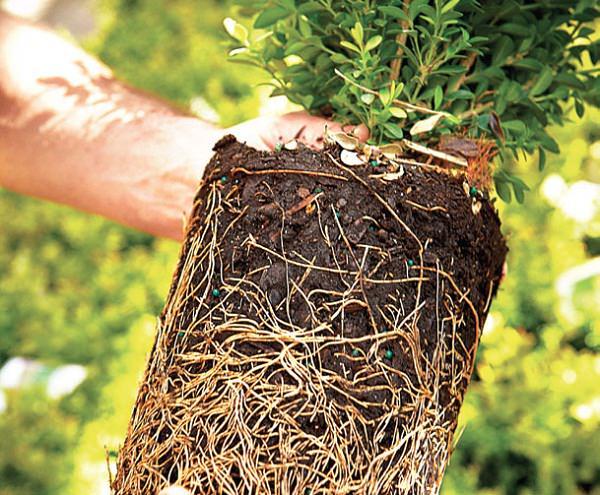
To have healthy plants and abundant blooms– nurse the roots, and remember that it is through them the plants absorb nutrients and water from the soil. When you perform the transplant or when you dig soil around the plant be careful not to cut or damage the roots as if being damaged plant would take a while to recover or it may die.
6. Apply mulch

Plants growing in a mulched soil are usually more vigorous, less prone to pests and diseases.
7. Do moderate watering
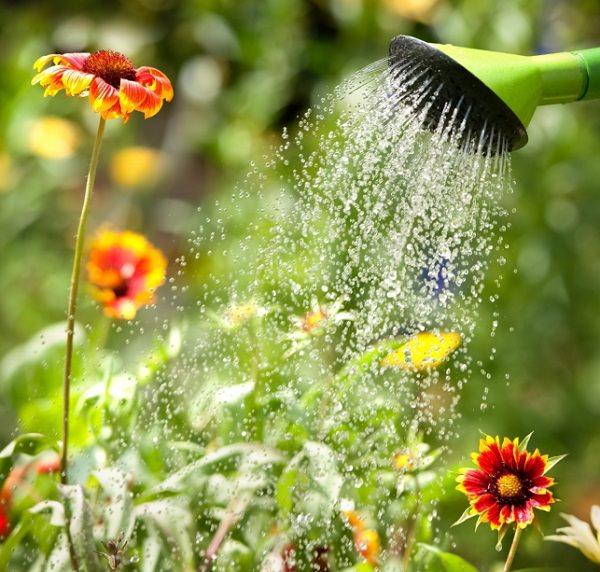
Excess watering tends to favor the development of foliage but can also produce the absence of flowering. Similarly, the lack of water can cause the plant to drop the flower buds. The best way is to do moderate watering (avoiding both overwatering and underwatering) during the flowering season.

Soil that is light and rich in compost or manure provides plenty of nutrients constantly to the plants. A soil that is rich in organic matter also encourages bacterial activity that promotes soil fertility. Add some compost or manure to the soil when planting your plants and go adding them time to time.
2. Deadhead often

Most plants grow better and have more flowers if their wilted and faded blooms are plucked often. When you see the wilted flowers, remove them, so the plant can direct its energy on other flowers and they will be receiving more nutrients. Wilted flowers waste energy and sap. They also attract insect and pests. Also, by cutting off the spent flowers you prevent plants from seeding.
3. Fertilize the plants

To have more flowers, feed the plants regularly during the growing season with half strength liquid fertilizer, a flowering fertilizer should be used that has more phosphorus than nitrogen, as phosphorus is the element that promotes more flower buds. Also, you can mix time-based fertilizer in the soil at the beginning of the growing season.
4. Provide more sun

Light is essential for the plant’s growth, direct sunlight for several hours a day can be a prerequisite for many plants that come to flower, however, shade loving plants tend to reduce the number of flowers when exposed to more sun.
5. Nurse the roots

To have healthy plants and abundant blooms– nurse the roots, and remember that it is through them the plants absorb nutrients and water from the soil. When you perform the transplant or when you dig soil around the plant be careful not to cut or damage the roots as if being damaged plant would take a while to recover or it may die.
6. Apply mulch

Plants growing in a mulched soil are usually more vigorous, less prone to pests and diseases.
7. Do moderate watering

Excess watering tends to favor the development of foliage but can also produce the absence of flowering. Similarly, the lack of water can cause the plant to drop the flower buds. The best way is to do moderate watering (avoiding both overwatering and underwatering) during the flowering season.
1
1
文章
Abigal
2017年05月22日

Checkout 19 best pergola plants for your garden. These climbing plants for pergolas and arbors can also be grown in small gardens easily.

There are so many climbing plants that can be guided over a pergola to get a welcome shade in warm weather. For your help, here we have listed 19 best pergola plants. This list is a combination of both tropical and temperate vines.
Best Pergola PlantsRose

Roses are classic. They are the favorite plants of most gardeners as they produce a feeling of being special, tranquility, nostalgia, romance, and happiness. Climbing varieties are perfect to cover a pergola and arches.
Clematis

Surely, one of the best pergola plants. Clematis is a spectacular vine as it blooms abundantly, flowering usually starts from spring. You can grow it easily and combine with other plants, especially with climbing roses to get a more exquisite view.
Honeysuckle

The fragrance of honeysuckle flowers is nostalgic and multiplies when dusk sets. It has more than 180 different species, almost all are creepers. It is a very large vine that grows rapidly, a single honeysuckle plant can cover up a big sturdy pergola easily.
Passion Flower (Passiflora)

Passion flower is a beautiful fast growing, hardy perennial in tropics. The heady fragrance, colorful flowers, and edible fruits make it one of most desirable climbing plant you can have in your garden. You can also grow it on your balcony, rooftop or patio garden. Growing passion flower is easy if you live in the subtropical or tropical climate (USDA Zone 8 – 11). If you live in the temperate region then look for its cold hardy cultivars. In very cool climate you can grow it as annual.
Jasmine
 "1000084172_1000000025_1487218527.jpg">Surely, jasmine is the most intense flower. Its fragrance can be smelt from far-far away. So if you love fragrant plants, grow it. In warm and humid climates jasmine blooms year round. In cooler zones, grow it as annual.
"1000084172_1000000025_1487218527.jpg">Surely, jasmine is the most intense flower. Its fragrance can be smelt from far-far away. So if you love fragrant plants, grow it. In warm and humid climates jasmine blooms year round. In cooler zones, grow it as annual.
Grape Vine

Truly one of the best climbing plants for pergolas, grape vine will not only give shade and a warm sitting place but juicy grapefruits too. You can grow this in a variety of climates. Grapevine varieties are native to Mediterranean, Central Asia, America and South West Asia, thus cultivars available diversely. Here’s an interesting article on training grapevine on arbor, which you can read.
Wisteria

Lavender blue color of wisteria flowers and the sweet fragrance is fascinating. However, wisteria is an aggressive grower but it takes the time to establish. You can grow wisteria in temperate and subtropical regions (USDA Zones 4 – 9). If you have a large sturdy pergola grow wisteria on it, you’ll need to prune regularly to control its growth.
Trumpet Vine (Campsis radicans)

Due to its showy trumpet-shaped flowers, it is called trumpet vine. Each of trumpet vine flowers can appear in different colors (orange, yellow or red). The flowers attract pollinators: bees, and hummingbirds. This plant looks great on the arches, pergolas, and trellises. It grows best in full sun to part sun.
Bignonia (Cross Vine)

Another beautiful climber, related to trumpet vine. Its delicate bell-shaped flowers look great on pergolas. It is a fairly vigorous plant and tolerates mild to moderate frost, grows best in USDA Zones (6 – 9). You can also try growing it in tropics (Zone 10) in shade from afternoon sun.
Ivy

For the arbors, pergolas, and gazebos situated in shade, ivy is best. It is low maintenance and tolerates the exploits of weather and provides lush green color. You can also choose variegated varieties.
Bougainvillea

The climbing varieties of bougainvillea are suitable for the pergolas. This plant loves the sunny position and does not like wet feet. Among the most frequently cultivated colors are pink, red, yellow and purple but it comes in many other colors too.
Morning glory

A vine that greets the morning sun with its pretty blooms. Morning glory vine is fairly easy to grow and it perks up quickly. A good plant to cover up a pergola that is in a sunny position.
Kiwi

A kiwi vine takes a lot of space to grow that is why it is one of the best pergola plants in our list. In order to get fruits from the kiwi plant, you’ll need to have both male and female plants for pollination.
Sweet pea

Don’t grow bush type varieties if you are growing it over the pergola. Plant sweet peas in the sun and in a well-drained soil. Grow sweet peas in warm zones in fall and winter. In temperates plant this fragrant vine in spring or summer.
Bleeding heart

If you’re searching for a climber for shade, bleeding heart is one. Its beautiful heart shaped flowers looks exotic. This plant requires moist soil and a location that receives partial sun. Bleeding heart is suitable for cold temperate climates and can be grown in USDA Zones 3 – 9.
Tropical Bleeding Heart (Glory Bower)

Exquisite flowers and dark glossy foliage. The tropical bleeding heart vine is native to Western Africa, its flowers resemble the bleeding heart (Dicentra spectabilis), see above. Both have different requirements and tropical bleeding heart thrives well in heat and warmth (USDA Zones 10 – 11). *You can also grow it as a houseplant.
Butterfly Pea

Butterfly pea flowers are the best food source for butterflies. It is a legume and both flowers and seed pods are edible. The most attractive thing about butterfly pea vine is its shiny deep blue flowers. Butterfly pea is a tropical vine and grows best in USDA Zones 10 and 11. In a cold temperate zone, grow this perennial as annual.
Golden Hops

A fast growing vine that quickly covers up the trellises, pergolas, and arches. Golden hops can grow up to 8 m long without any difficulty. What makes it beautiful is its lime green or yellowish foliage. It is a low maintenance cold hardy vine (USDA Zones 4 – 8), not suitable for warm climates.
Climbing Hydrangea

Growing climbing hydrangea vine is rewarding due to its glossy heart-shaped foliage and fragrant white flowers that appear in clusters in spring to summer. It is a slow grower and requires training and pruning. You can grow climbing hydrangea if you live in the colder region within USDA Zones 5 – 8.

There are so many climbing plants that can be guided over a pergola to get a welcome shade in warm weather. For your help, here we have listed 19 best pergola plants. This list is a combination of both tropical and temperate vines.
Best Pergola PlantsRose

Roses are classic. They are the favorite plants of most gardeners as they produce a feeling of being special, tranquility, nostalgia, romance, and happiness. Climbing varieties are perfect to cover a pergola and arches.
Clematis

Surely, one of the best pergola plants. Clematis is a spectacular vine as it blooms abundantly, flowering usually starts from spring. You can grow it easily and combine with other plants, especially with climbing roses to get a more exquisite view.
Honeysuckle

The fragrance of honeysuckle flowers is nostalgic and multiplies when dusk sets. It has more than 180 different species, almost all are creepers. It is a very large vine that grows rapidly, a single honeysuckle plant can cover up a big sturdy pergola easily.
Passion Flower (Passiflora)

Passion flower is a beautiful fast growing, hardy perennial in tropics. The heady fragrance, colorful flowers, and edible fruits make it one of most desirable climbing plant you can have in your garden. You can also grow it on your balcony, rooftop or patio garden. Growing passion flower is easy if you live in the subtropical or tropical climate (USDA Zone 8 – 11). If you live in the temperate region then look for its cold hardy cultivars. In very cool climate you can grow it as annual.
Jasmine
Grape Vine

Truly one of the best climbing plants for pergolas, grape vine will not only give shade and a warm sitting place but juicy grapefruits too. You can grow this in a variety of climates. Grapevine varieties are native to Mediterranean, Central Asia, America and South West Asia, thus cultivars available diversely. Here’s an interesting article on training grapevine on arbor, which you can read.
Wisteria

Lavender blue color of wisteria flowers and the sweet fragrance is fascinating. However, wisteria is an aggressive grower but it takes the time to establish. You can grow wisteria in temperate and subtropical regions (USDA Zones 4 – 9). If you have a large sturdy pergola grow wisteria on it, you’ll need to prune regularly to control its growth.
Trumpet Vine (Campsis radicans)

Due to its showy trumpet-shaped flowers, it is called trumpet vine. Each of trumpet vine flowers can appear in different colors (orange, yellow or red). The flowers attract pollinators: bees, and hummingbirds. This plant looks great on the arches, pergolas, and trellises. It grows best in full sun to part sun.
Bignonia (Cross Vine)

Another beautiful climber, related to trumpet vine. Its delicate bell-shaped flowers look great on pergolas. It is a fairly vigorous plant and tolerates mild to moderate frost, grows best in USDA Zones (6 – 9). You can also try growing it in tropics (Zone 10) in shade from afternoon sun.
Ivy

For the arbors, pergolas, and gazebos situated in shade, ivy is best. It is low maintenance and tolerates the exploits of weather and provides lush green color. You can also choose variegated varieties.
Bougainvillea

The climbing varieties of bougainvillea are suitable for the pergolas. This plant loves the sunny position and does not like wet feet. Among the most frequently cultivated colors are pink, red, yellow and purple but it comes in many other colors too.
Morning glory

A vine that greets the morning sun with its pretty blooms. Morning glory vine is fairly easy to grow and it perks up quickly. A good plant to cover up a pergola that is in a sunny position.
Kiwi

A kiwi vine takes a lot of space to grow that is why it is one of the best pergola plants in our list. In order to get fruits from the kiwi plant, you’ll need to have both male and female plants for pollination.
Sweet pea

Don’t grow bush type varieties if you are growing it over the pergola. Plant sweet peas in the sun and in a well-drained soil. Grow sweet peas in warm zones in fall and winter. In temperates plant this fragrant vine in spring or summer.
Bleeding heart

If you’re searching for a climber for shade, bleeding heart is one. Its beautiful heart shaped flowers looks exotic. This plant requires moist soil and a location that receives partial sun. Bleeding heart is suitable for cold temperate climates and can be grown in USDA Zones 3 – 9.
Tropical Bleeding Heart (Glory Bower)

Exquisite flowers and dark glossy foliage. The tropical bleeding heart vine is native to Western Africa, its flowers resemble the bleeding heart (Dicentra spectabilis), see above. Both have different requirements and tropical bleeding heart thrives well in heat and warmth (USDA Zones 10 – 11). *You can also grow it as a houseplant.
Butterfly Pea

Butterfly pea flowers are the best food source for butterflies. It is a legume and both flowers and seed pods are edible. The most attractive thing about butterfly pea vine is its shiny deep blue flowers. Butterfly pea is a tropical vine and grows best in USDA Zones 10 and 11. In a cold temperate zone, grow this perennial as annual.
Golden Hops

A fast growing vine that quickly covers up the trellises, pergolas, and arches. Golden hops can grow up to 8 m long without any difficulty. What makes it beautiful is its lime green or yellowish foliage. It is a low maintenance cold hardy vine (USDA Zones 4 – 8), not suitable for warm climates.
Climbing Hydrangea

Growing climbing hydrangea vine is rewarding due to its glossy heart-shaped foliage and fragrant white flowers that appear in clusters in spring to summer. It is a slow grower and requires training and pruning. You can grow climbing hydrangea if you live in the colder region within USDA Zones 5 – 8.
0
0
文章
Gina
2017年05月22日
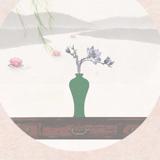

If you are like most of us, sometime this summer you might want to leave town for a few days. Really inconvenient from the point of view of your container plants, but hey, we’re human! No need to hire the next door neighbors kid to creep into your back yard for thirty seconds each day to wet the soil surface and then run off to the mall. Here are some great DIY self watering ideas for your garden, so no matter how much fun you have on vaca, you don’t come back to a plant funeral.
Number 1:
My personal fav – wine bottle watering. I have personally tested this one out folks. (I knew my love of red wine was good for something other than, well, my love of red wine!)
Rinse an empty wine bottle, (or other glass bottle with a narrow neck) and fill with water. Standing next to your planter, quickly turn over the bottle and push the neck down into the soil near the center of the planter. Make sure the neck is at least several inches underground. The water in the bottle will seep into the soil over several days, keeping the soil evenly moist. It works! Check out how ‘Lettuce Share‘ added some extra modifications (photo above) and made it even better.
Number 2:
This one is better for a larger container or planter, or even a delicate plant in ground that needs a more constant water supply. Rinse an empty two liter soda bottle. Cut the neck off so that the top opening can be easily filled with a hose. Or cut off the bottom and place the bottle upside down. The cut open bottom now becomes the “neck”. Punch or cut small holes randomly through the body of the bottle, as shown in the photo. Dig a hole big enough to bury the bottle in either the center of the planter, or right next to the root system of a plant that is in ground. Pack soil up to the open neck of the bottle. Fill the bottle with water from the top. The water will seep slowly through the holes in the bottle, into the soil. Being buried in the soil will help prevent too much evaporation. This method also promotes a deep root system.

Number 3:
Use a commercially bought “cheat”… You can either purchase the “as seen on TV” Aqua Globes, or something like it, or you can use the wine bottle technique above with pop bottles by getting yourselves Nanny Stakes to insert the neck into. These give the weaker plastic bottle the strength to be pushed deep enough into the soil.
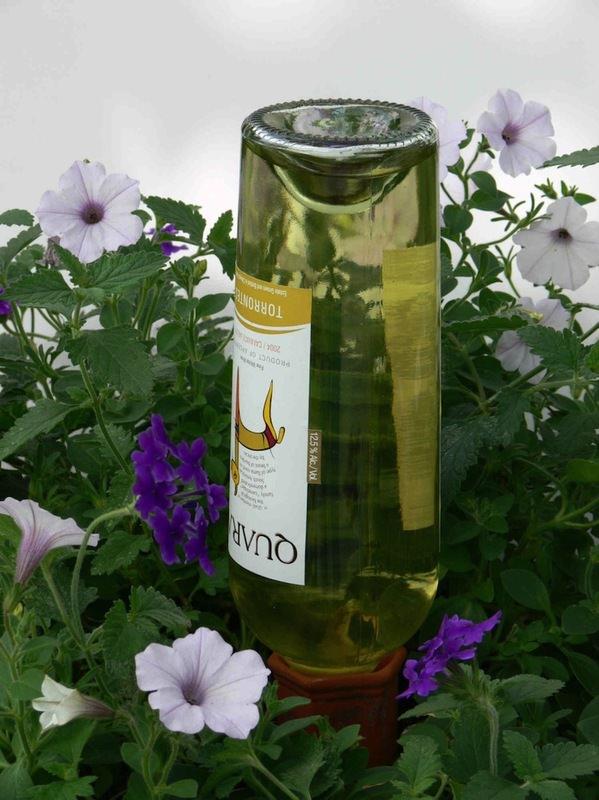

So go ahead, get outta town! These DIY self watering ideas for your garden will keep it all green and happy for your return!
0
0
文章
Abigal
2017年05月21日


We don’t always think of our outdoor spaces like rooms, but we should! There should be design elements in every garden that make us smile, and that shouldn’t be limited to just plants. Garden fences are like our virtual “walls” in a garden, and if you think of them that way, you know they need some sprucing! As you would hang photos and art on your interior walls, don’t be afraid to try these 15 creative garden fence spruce ups! Keeyla Meadows is one of my favorite garden artists, and she would tell you that nature is a work of art, so celebrate it! She introduced me some years ago to the idea of a garden as more than just flowers and plants in her book, ‘Making Gardens Works of Art”. So let’s do like Keeyla, and and spruce up (at least) our fences! The photo above, is from Keeyla’s Morroccan sanctuary garden. Ok, we probably aren’t going to weld and form and paint and sculpt a fence like this entry gate. But let it inspire you to think creatively!
‘Chris H. Olsen‘ has the idea, he used store bought metal flowers, but then spray painted them a vibrant color and hung them on the garden fence! You could even do this with old tools, or even rusty metal parts.
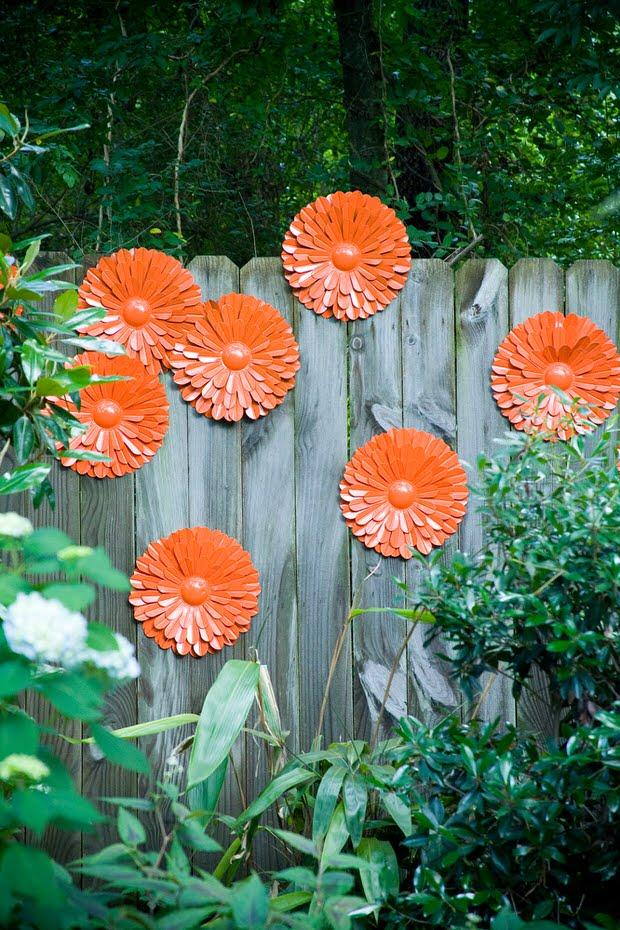
So we found this idea on Pinterest, but we love it! This is colored glass marbles set into a pattern in the fence. You could recreate this by first tracing out your pattern onto the fence with pencil, marking where each hole for each marble should go. Make sure the drill bit you use is just a tiny bit smaller than the diameter of the marble, and then drill your holes. You want the marble to fit very tightly in each hole so they will stay in place. Practice with your drill bit(s) to check for sizing on a scrap piece of wood first. BTW, if anyone knows who did this project, please share it with us in comments or email.

From ‘Sensibly Sara’, this DIY fence table is perfect for extra space when entertaining, a potting bench, a play space for the kids (perfect place to finger paint!) or even a place to do home work on a nice day! Simple, easy to follow tutorial.

Some sticks and some plywood come together to make this DIY outdoor letter art from ‘Better Homes and Gardens Australia’. I could think of so many words I would like to see on my garden fence!

CC at ‘Hometalk‘ made this amazing faux secret garden door on the fence. Starting with an old door, porch poles, bunk bed slats, and even flower pots as finials turned this salvage into something sweet!

From ‘Garden Tenders‘, this dragonfly art looks right at home here on this fence. Want to know how to do something like this yourself? Check out our post on TBD on garden spruce ups.

Donna at ‘Funky Junk Interiors‘, hung this canning jar lid wreath on her fence for a little rusty charm. This is simply old canning jar lids strung onto an old tie!

‘Babblings and More‘ used an old window and some jars to create a homey little vignette. They filled the jars with stones to keep them in place. Cute!

‘Creative Star Learning‘ made this fence hung water wall (it’s almost like a fancy rain chain!) from bamboo.

From ‘There Was a Crooked House‘, this is a brilliant idea on a budget! After you paint your frames, we recommend giving them a coat of clear exterior sealer to extend their life outdoors.

We found this idea on Pinterest, and it’s pretty simple. Hang string lights from your fence line!

From ‘Creative Raisins‘, these antique looking signs are actually DIY reproductions!

‘Flea Market Gardening‘ simply found this cute barrel hoop heart hung on a fence from Patty Hicks. Adorable!

So finally, another Pinterest photo we can’t find a source for, but didn’t want to let go by. This tree painting on a fence would not be hard to do, think kindergarten! (Ok, maybe a little time consuming. Scale it down, maybe?) So fun!

0
0



